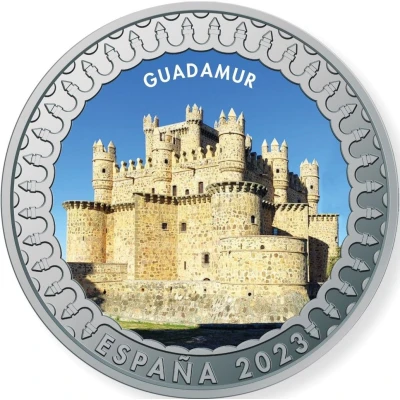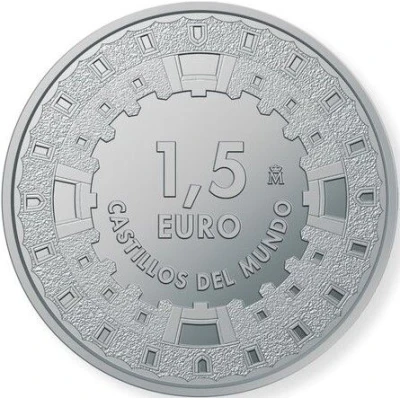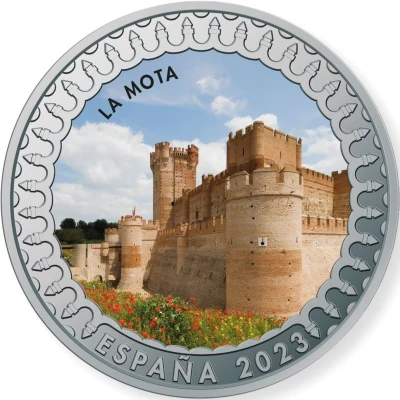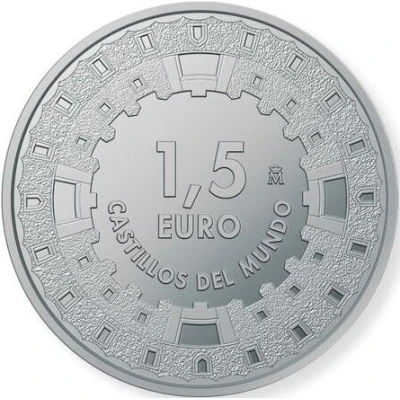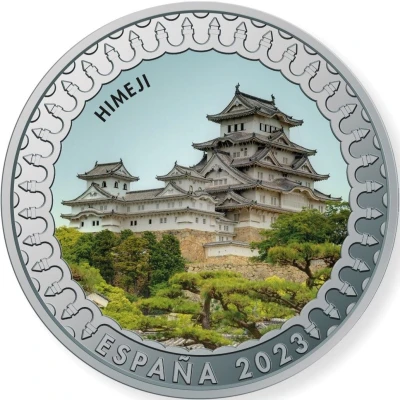


© Real Casa de la Moneda
1.5 Euro Castle of Himeji
2023 year| Copper-nickel (75% copper, 25% nickel) | 15 g | 33 mm |
| Issuer | Spain |
|---|---|
| King | Felipe VI (2014-date) |
| Type | Non-circulating coin |
| Year | 2023 |
| Value | 1.5 Euro 1.50 EUR = USD 1.65 |
| Currency | Euro (2002-date) |
| Composition | Copper-nickel (75% copper, 25% nickel) |
| Weight | 15 g |
| Diameter | 33 mm |
| Shape | Round |
| Technique | Milled, Coloured |
| Orientation | Medal alignment ↑↑ |
| Updated | 2024-10-07 |
| Numista | N#383808 |
|---|---|
| Rarity index | 97% |
Reverse
On the outside part of the the reverse (common to all the coins), allegory of the structure of the castles.
Script: Latin
Lettering:
CASTILLOS DEL MUNDO
1,5 EURO
M
Translation: Castles of the World
Edge
Plain
Comment
Himeji Castle: In the Japanese coastal town of Himeji, visible from almost the entire town due to its location on Himeyama hill, rising in the middle of the town, stands the castle of the same name, a UNESCO World Heritage Site since 1993.Its origins can be traced back to the Middle Ages. Its construction was ordered by Akamatsu Sadanori in 1346, although new buildings were subsequently added and others were modified by the various clans and feudal lords who ruled the region, until it achieved its present appearance as a group of more than 80 buildings, which make Himeji Castle a masterpiece of wooden architecture.
This is one of the few castles in Japan that has remained virtually intact since its inception, having been spared the frequent earthquakes that beset that part of the world and Second World War bombing raids, no doubt helped by the fact that the castle was darkened to prevent it from being spotted by enemy aircraft. Fortunately, an incendiary bomb that did fall on the main tower failed to explode.
It is easy to lose your way among the proliferation of walls and ramparts, gates, winding paths, passages and stairways on the grounds inside the castle complex, a complicated defensive design, labyrinthine at times, clearly devised with the intention of creating confusion for potential invaders. Interestingly, there are 997 sama, or loopholes, distributed throughout the outer and inner walls of the complex, made in different shapes (rectangular, square, triangular and round) so that different weapons could be introduced through them.
Himeji Castle is of the hirayamajiro type, meaning that it is built on a hill surrounded by a plain. Its keep, or tenshu – the best-known feature of the castle – has six storeys, one of which is a basement. All footwear must be removed before entering. Although originally built in 1580 by Toyotomi Hideyoshi, it was dismantled and rebuilt shortly afterwards. Standing on Himeyama hill, 46 metres above sea level, the tower rises another 46 metres, bringing the castle’s total height to 92 metres above sea level, making it an extraordinary vantage point overlooking the city.
It is the most visited castle in Japan and one of the most beautiful after its recent six-year restoration. It is one of Japan’s Three Famous Castles, along with Matsumoto Castle and Kumamoto Castle, and is regularly featured in films and TV series set in Japan.
The bright, immaculate white walls, made of fireproof material, have led to the castle also being named White Heron Castle.
Interesting fact
The Castle of Himeji, depicted on the 1.5 Euro non-circulating coin from Spain, is a UNESCO World Heritage Site and one of Japan's most beautiful and well-preserved castles.
Price
| Date | Mintage | VG | F | VF | XF | AU | UNC |
|---|---|---|---|---|---|---|---|
| 2023 M | 5000 | - | - | - | - | - | - |
Values in the table are based on evaluations by sales realized on Internet platforms. They serve as an indication only for 1.5 Euro (Castle of Himeji) 2023 coin.
